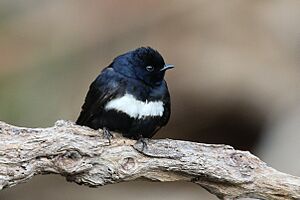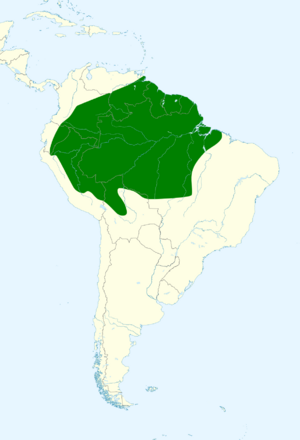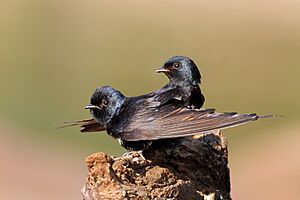White-banded swallow facts for kids
Quick facts for kids White-banded swallow |
|
|---|---|
 |
|
| Cristalino River, Southern Amazon, Brazil | |
| Conservation status | |
| Scientific classification | |
| Genus: |
Atticora
|
| Species: |
fasciata
|
 |
|
| Range of white-banded swallow Resident range | |
The white-banded swallow (scientific name: Atticora fasciata) is a cool bird from the Hirundinidae family, which includes all swallows and martins. This bird is mostly black, but it has bright white patches on its thighs, chest, and the edges of its wings. It also has a unique, deeply split tail.
You can find these swallows in tropical lowlands across South America, including countries like Brazil, Colombia, and Peru. They love living near rivers and in forests. Unlike some birds, they don't migrate, meaning they stay in the same area all year. They build their nests in burrows, often in riverbanks. The International Union for Conservation of Nature (IUCN) lists the white-banded swallow as a species of least concern, meaning it's not currently in danger.
Contents
About the White-Banded Swallow
The white-banded swallow was first officially described in 1789 by a German scientist named Johann Friedrich Gmelin. He gave it the scientific name Hirundo fasciata. Later, in 1842, an English bird expert, John Gould, placed it in a new group called Atticora. The name Atticora comes from ancient Greek words meaning "Athenian maiden," a term often used for swallows. The word fasciata comes from Latin and means "band," referring to the white band on its chest. This bird does not have different types or subspecies.
What Does It Look Like?

The white-banded swallow is a medium-sized bird. It is about 15 cm (6 inches) long and weighs between 12 and 16 grams (about half an ounce). Its wingspan is usually between 92 and 108 mm (3.6 to 4.3 inches).
These swallows are mostly black, but they have a clear white band across their chest. Their thighs and the edges of their wings are also white. Their feathers have a shiny, blue-black look. They have a tail that is deeply forked, like a "V" shape. Male and female swallows look very similar, but females might be a tiny bit heavier. Young white-banded swallows are usually duller and browner than the adults.
It's easy to tell this bird apart from the black-collared swallow. The black-collared swallow has a white belly and throat, which the white-banded swallow does not.
The white-banded swallow makes a call that sounds like ti-ti-tur. When flying, they also make a buzzing sound, like z-z-z-z-ee-eep.
Where Do They Live?
These birds live in several South American countries. You can find them in Bolivia, Brazil, Colombia, Ecuador, French Guiana, Guyana, Peru, Suriname, and Venezuela.
They prefer to live in tropical lowland forests that are near water. They can be found near both blackwater rivers (dark, tea-colored rivers) and whitewater rivers (cloudy, sediment-filled rivers). In some areas, like Colombia and Venezuela, they are more often seen near blackwater rivers, where they nest on rocky cliffs. Even though they live near water, they are rarely found over large lakes. They sometimes fly over clearings in the forest.
White-banded swallows usually live below 800 meters (2,600 feet) in elevation. However, in Colombia, they can be found as high as 1,400 meters (4,600 feet). These swallows do not migrate; they stay in their home areas all year long.
How They Behave
Reproduction and Nesting
White-banded swallows build their nests in burrows. Scientists believe they dig their own burrows, sometimes in riverbanks when the water level is low. They might also use burrows that other animals have left behind. Their nests are made of dry grass. These birds do not use man-made nesting spots.
They usually breed alone or in small groups. In the evening, you might see them resting together in small groups. A female swallow typically lays four to five white eggs. Each egg is about 18.5 mm by 12.8 mm (0.73 by 0.5 inches).
What Do They Eat?
White-banded swallows are insectivores, meaning they eat insects. They catch their food while flying in the air. When they are looking for food, they fly very fast in a zigzag pattern or circle above the water. Sometimes, they even skim the surface of the water.
Occasionally, they will perch on rocks or small ledges above the water. They usually hunt for insects low over the water, or sometimes near forests, open clearings, or grassy areas with bushes. They often hunt alone or in small groups. Sometimes, they might forage with other swallows, like the black-collared swallow or the white-winged swallow, but they usually stay closer to rocks.
Conservation Status
The white-banded swallow is listed as a least-concern species by the IUCN. This means that even though their population is slowly decreasing, they are not considered to be in immediate danger of extinction. There are a few reasons for this classification:
- They have a very large range, covering about 7.26 million square kilometers (2.8 million square miles).
- Their total population is still quite large.
- The rate at which their population is decreasing is not fast enough to classify them as vulnerable.
The main reason for the population decline is that they are estimated to lose about 12.8% to 13.8% of their suitable living areas over a 12-year period, which is about three generations for these birds.


